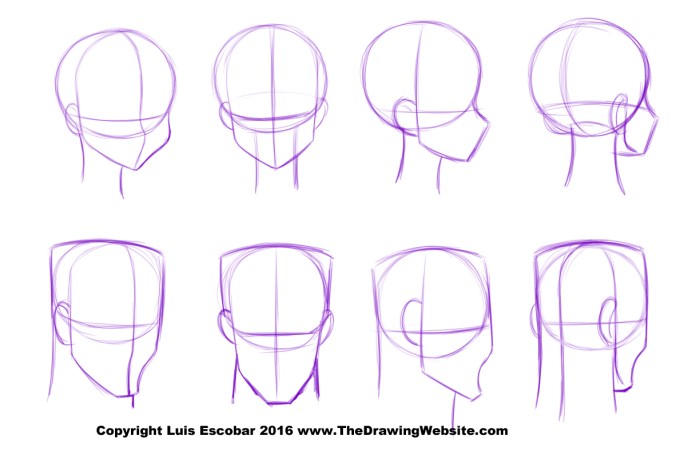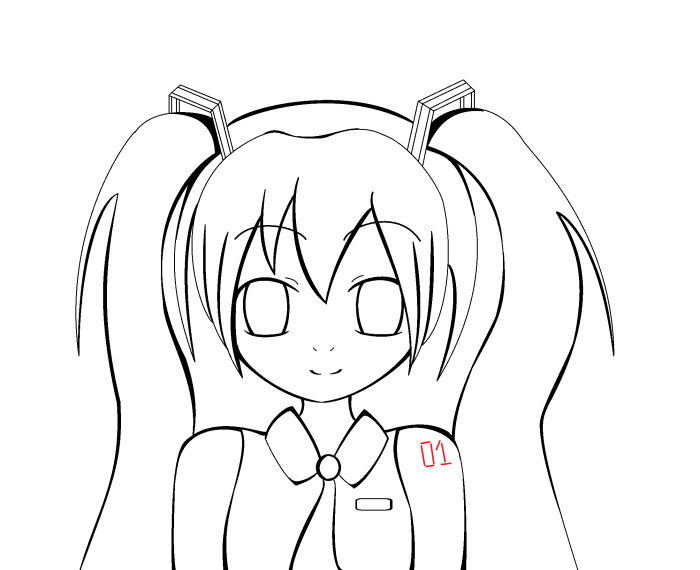Techniques for Applying Base Colors
Anime head base coloring – Applying base colors is a foundational step in digital anime head coloring, impacting the overall look and feel of the final artwork. The choice of technique and the approach to color blending significantly influence the realism and style of the piece. Different methods offer varying levels of control and efficiency, allowing artists to tailor their workflow to their preferences and the specific demands of the project.
Digital Painting Techniques for Base Colors
Several digital painting techniques can be used to apply base colors. Flat coloring provides a clean, graphic look, ideal for stylized anime. Airbrushing creates soft, blended transitions, useful for achieving smooth skin tones or subtle shading. Blending involves directly mixing colors on the canvas, offering more control over color transitions and allowing for a more painterly approach. The choice depends on the desired style and level of detail.
For example, a cel-shaded style would benefit from flat coloring, while a more realistic style might use airbrushing and blending extensively.
Mastering anime head base coloring involves understanding proportions and shading techniques. For inspiration, you might find useful resources like the character designs showcased in the anime expo 2018 xeno coloring pages , which offer a glimpse into professional coloring styles. Observing these examples can significantly enhance your own approach to anime head base coloring, improving both accuracy and artistry.
Color Blending Modes for Realistic Skin Tones
Color blending modes in digital painting software significantly enhance the ability to achieve realistic skin tones. Modes like “Multiply,” “Overlay,” and “Soft Light” are particularly useful. “Multiply” darkens the base color, ideal for adding shadows. “Overlay” increases color saturation, enhancing highlights and creating a more vibrant effect. “Soft Light” subtly blends colors, creating a smooth transition between light and shadow.
Experimenting with these modes and adjusting their opacity allows for a nuanced and natural-looking skin tone. For instance, using a reddish-brown base color, applying a slightly lighter peach tone in “Overlay” mode for highlights, and a darker brown in “Multiply” for shadows creates a believable skin tone.
Step-by-Step Guide for Applying Base Colors in Clip Studio Paint
The following steps demonstrate applying base colors using Clip Studio Paint. This process can be adapted to other software with similar tools.
| Step | Action | Tip |
| 1 | Create a new layer above your line art. | Ensure the line art is on a separate layer. |
| 2 | Select the Fill tool (bucket tool). | Choose a color for the base skin tone. |
| 3 | Fill the line art with the base skin color. | Use the “Refer to other layers” option to ensure accurate filling within the lines. |
| 4 | Create new layers for hair, eyes, and clothing. | Organize layers for efficient workflow. |
| 5 | Repeat steps 2 and 3 for each area, selecting appropriate base colors. | Consider using color palettes or references for consistency. |
| 6 | Use the airbrush tool to soften harsh edges. | Experiment with different airbrush settings for varying levels of softness. |
| 7 | Refine colors and add subtle shading using blending modes. | Use “Multiply” for shadows and “Overlay” or “Soft Light” for highlights. |
Brush Types and Settings for Varied Textures
Different brush types and settings significantly influence the texture and appearance of base colors. A hard brush creates sharp, defined edges, suitable for flat coloring or adding details. A soft brush produces smooth transitions, ideal for blending and creating soft gradients. Adjusting settings such as opacity, size, and flow allows for precise control over color application. For example, a hard brush with low opacity can be used to add subtle highlights or shadows, while a soft brush with high opacity can be used to create large areas of solid color.
Experimenting with different brushes and their settings helps achieve a wide range of textural effects.
Shading and Highlights on Anime Heads: Anime Head Base Coloring

Adding shadows and highlights to your anime head base colors is crucial for creating depth, volume, and a sense of realism, even within the stylized world of anime. This process transforms a flat image into a three-dimensional representation, enhancing the overall visual appeal of your character. Proper shading and highlighting techniques effectively communicate the light source and the form of the head.
The placement of shadows and highlights is directly influenced by the light source’s position and intensity. Understanding this relationship is key to achieving believable results. Generally, anime art utilizes a simplified approach to shading and highlighting, often focusing on key areas to convey the desired effect rather than meticulously rendering every detail.
Key Areas for Shading and Highlights
Shadows and highlights are typically concentrated on specific areas of the anime head to emphasize its form. These areas include the hairline, the sides of the nose, the underside of the chin, and the areas around the eyes and cheeks. The intensity and extent of these shadows and highlights will vary depending on the light source and the character’s pose.
The forehead often receives a highlight, while the hair itself provides opportunities for both shadows and highlights, reflecting the light and creating strands.
Influence of Light Sources, Anime head base coloring
The direction and intensity of the light source dramatically impact the placement and intensity of shadows and highlights. A light source from above will create shadows underneath the nose, chin, and hairline, while a light source from the side will create more pronounced shadows on one side of the face. Backlighting, where the light source is behind the subject, will create a rim light around the edges of the head, enhancing its three-dimensionality.
Multiple light sources will lead to a more complex interplay of shadows and highlights, adding complexity and depth to the illustration. Consider the time of day – a harsh midday sun will create strong, defined shadows, whereas softer, diffused light, like that found during dawn or dusk, will produce gentler shading.
Illustrative Progression of Shading and Highlights
Understanding the process is best illustrated through a series of images. Imagine the following progression:
- Image 1: Flat base color. This image shows a simple, flat color rendering of an anime head, lacking any shading or highlights. The head appears two-dimensional and lacks volume.
- Image 2: Initial shadow placement. In this image, basic shadows are added to the underside of the chin, the sides of the nose, and the hairline. These shadows are generally darker than the base color and are applied broadly, establishing the initial form.
- Image 3: Highlight addition. Highlights are now added to the forehead, cheekbones, and bridge of the nose. These highlights are generally lighter than the base color and are applied strategically to emphasize the form and give the head a sense of roundness.
- Image 4: Refined shading and highlights. This final image shows a refined version of the shading and highlights. The shadows and highlights have been blended and softened, creating a smoother transition between tones. Details have been added, like subtle shadows within the hair and around the eyes, enhancing the realism and depth of the illustration. The overall effect is a three-dimensional and visually appealing anime head.
Advanced Techniques and Styles

Building upon the foundational techniques of base coloring, shading, and highlighting, let’s delve into more advanced approaches to elevate your anime head coloring. This section explores various stylistic choices and their impact on the final result, moving beyond the basics to achieve unique and expressive character portraits.
Different anime styles employ distinct approaches to base coloring, reflecting the overall aesthetic of the work. These differences extend beyond simple color choices and involve the level of detail, the use of shading, and the overall rendering style.
Anime Style Comparisons and Base Coloring Approaches
Anime styles vary widely, from the clean lines and vibrant colors of a show like Sailor Moon to the more detailed and textured approach seen in works like Made in Abyss. Sailor Moon’s style often uses flat, bold colors with minimal shading, emphasizing clear Artikels and a graphic aesthetic. The base colors are crucial here, acting as the foundation for the overall vibrancy.
In contrast, Made in Abyss might use a more nuanced palette with subtle variations in base colors to create depth and texture, even before adding shading and highlights. This difference demonstrates how the base color choices directly reflect the artistic direction of the piece. The selection of a base color palette is a fundamental decision that dictates the overall mood and style of the piece.
A vibrant, saturated palette creates a cheerful and energetic feeling, while a muted, desaturated palette can convey a more serious or melancholic mood.
Line Art’s Influence on Base Color Application
The style of line art significantly impacts how base colors are applied. Clean, crisp line art, often found in many modern anime, allows for sharp, defined base colors with minimal blending. The lines themselves act as strong boundaries, guiding the application of color. Conversely, rougher, more textured line art, perhaps reminiscent of older manga styles, may require a more blended approach to base colors, softening the edges and creating a less defined, more painterly look.
The line weight itself also plays a role; thicker lines might suggest a more solid, less translucent application of color, while thinner lines might allow for more subtle gradations and transparency effects within the base color layer.
Achieving a Cel-Shaded Look with Base Colors
The cel-shaded look is characterized by its distinct, flat areas of color with sharp transitions between them. To achieve this, start with a clean, well-defined line art. Then, apply solid, unblended base colors within the lines. Avoid any gradients or shading within the base color layer itself. The cel-shaded effect is primarily created through the addition of distinct shadow and highlight colors, applied as flat blocks, rather than through gradual blending within the base colors.
The key to a successful cel-shaded look lies in the precise application of flat color areas and strong contrast between the base color, shadows, and highlights.
Creating Realistic Skin Texture with Base Colors and Blending
Achieving realistic skin texture with base colors requires a more nuanced approach. Begin by laying down a base color that reflects the overall skin tone. Then, gradually introduce subtle variations in color and value. Use slightly warmer tones in areas where light naturally hits the face (cheekbones, forehead, bridge of the nose), and cooler tones in recessed areas (under the eyes, jawline, nose bridge).
Employ blending techniques, such as soft airbrushing or blurring, to create smooth transitions between these color variations. This creates a more natural, three-dimensional look.
Remember to use subtle color variations for a more natural look.
